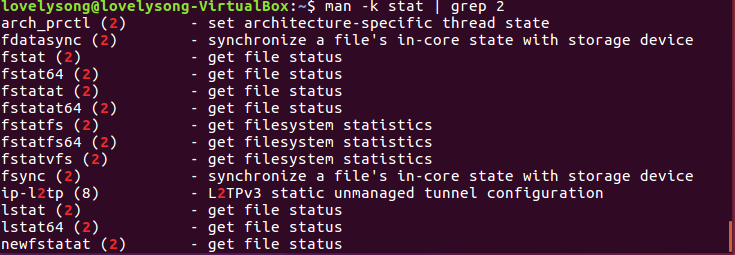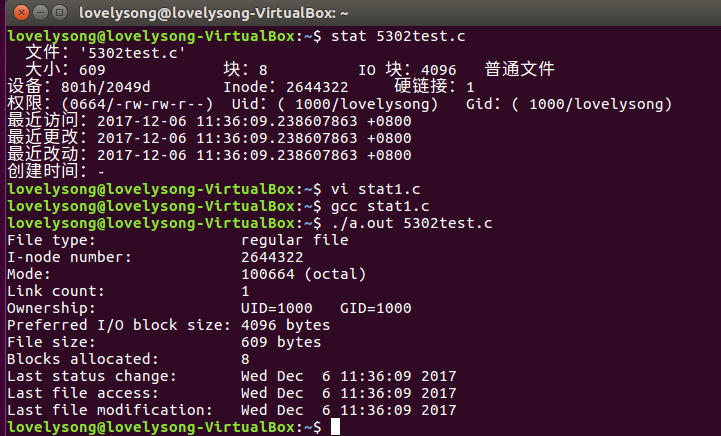# 2017-2018-1 20155302 课下实践IPC及课上补充
课上实践补交
题目二要求:
学习使用stat(1),并用C语言实现
提交学习stat(1)的截图
man -k ,grep -r的使用
伪代码
产品代码 mystate.c,提交码云链接
测试代码,mystat 与stat(1)对比,提交截图
问题探索与解决
首先学习stat(1)指令:使用指令man 1 stat

使用指令man -k stat


使用指令man -k stat | grep 2

伪代码:就是获取stat结构然后打印。
产品代码:
#include <sys/types.h>
#include <sys/stat.h>
#include <time.h>
#include <stdio.h>
#include <stdlib.h>
int main(int argc, char *argv[])
{
struct stat sb;
if (argc != 2) {
fprintf(stderr, "Usage: %s <pathname>\n", argv[0]);
exit(EXIT_FAILURE);
}
if (stat(argv[1], &sb) == -1) {
perror("stat");
exit(EXIT_FAILURE);
}
printf("File type: ");
switch (sb.st_mode & S_IFMT) {
case S_IFBLK: printf("block device\n"); break;
case S_IFCHR: printf("character device\n"); break;
case S_IFDIR: printf("directory\n"); break;
case S_IFIFO: printf("FIFO/pipe\n"); break;
case S_IFLNK: printf("symlink\n"); break;
case S_IFREG: printf("regular file\n"); break;
case S_IFSOCK: printf("socket\n"); break;
default: printf("unknown?\n"); break;
}
printf("I-node number: %ld\n", (long) sb.st_ino);
printf("Mode: %lo (octal)\n",
(unsigned long) sb.st_mode);
printf("Link count: %ld\n", (long) sb.st_nlink);
printf("Ownership: UID=%ld GID=%ld\n",
(long) sb.st_uid, (long) sb.st_gid);
printf("Preferred I/O block size: %ld bytes\n",
(long) sb.st_blksize);
printf("File size: %lld bytes\n",
(long long) sb.st_size);
printf("Blocks allocated: %lld\n",
(long long) sb.st_blocks);
printf("Last status change: %s", ctime(&sb.st_ctime));
printf("Last file access: %s", ctime(&sb.st_atime));
printf("Last file modification: %s", ctime(&sb.st_mtime));
exit(EXIT_SUCCESS);
}
stat指令与mystat测试比较:

2017-2018-1 20155302 课下实践IPC
共享内存
共享内存允许两个或多个进程共享一定的存储区,因为不需要拷贝数据,所以这是最快的一种IPC。
共享内存是在多个进程之间共享内存区域的一种进程间的通信方式,由IPC为进程创建的一个特殊地址范围,它将出现在该进程的地址空间(这里的地址空间具体是哪个地方?)中。其他进程可以将同一段共享内存连接到自己的地址空间中。所有进程都可以访问共享内存中的地址,就好像它们是malloc分配的一样。如果一个进程向共享内存中写入了数据,所做的改动将立刻被其他进程看到。
共享内存是IPC最快捷的方式,因为共享内存方式的通信没有中间过程,而管道、消息队列等方式则是需要将数据通过中间机制进行转换。共享内存方式直接将某段内存段进行映射,多个进程间的共享内存是同一块的物理空间,仅仅映射到各进程的地址不同而已,因此不需要进行复制,可以直接使用此段空间。
#include <sys/ipc.h>
#include <sys/shm.h>
(1)创建或访问共享内存
* int shmget(key_t key,size_t size,int shmflg);
(2)附加共享内存到进程的地址空间
* void *shmat(int shmid,const void *shmaddr,int shmflg);//shmaddr通常为NULL,由系统选择共享内存附加的地址;shmflg可以为SHM_RDONLY
(3)从进程的地址空间分离共享内存
* int shmdt(const void *shmaddr); //shmaddr是shmat()函数的返回值
(4)控制共享内存
* int shmctl(int shmid,int cmd,struct shmid_ds *buf);
* struct shmid_ds{
struct ipc_perm shm_perm;
…
};
cmd的常用取值有:(a)IPC_STAT获取当前共享内存的shmid_ds结构并保存在buf中(2)IPC_SET使用buf中的值设置当前共享内存的shmid_ds结构(3)IPC_RMID删除当前共享内存
代码实例:
建立共享内存并写入数据的程序
#include <stdio.h>
#include <string.h>
#include <sys/ipc.h>
#include <sys/shm.h>
#include <stdlib.h>
#include <errno.h>
void get_buf(char *buf)
{
int i=0;
while((buf[i]=getchar())!='\n'&&i<1024)
i++;
}
int main(void)
{
int shmid;
shmid=shmget(IPC_PRIVATE,sizeof(char)*1024,IPC_CREAT|0666);
if(shmid==-1)
{
perror("shmget");
}
char *buf;
if((int)(buf=shmat(shmid,NULL,0))==-1)
{
perror("shmat");
exit(1);
}
get_buf(buf);
printf("%d\n",shmid);
return 0;
}
读取数据的程序
#include <stdio.h>
#include <sys/ipc.h>
#include <sys/shm.h>
#include <stdlib.h>
int main(int argc,char **argv)
{
int shmid;
shmid=atoi(argv[1]);
char *buf;
if((int)(buf=shmat(shmid,NULL,0))==-1)
{
perror("shmat");
exit(1);
}
printf("%s\n",buf);
shmdt(buf);
return 0;
}
管道
管道的特点:
1、管道是半双工的,数据只能向一个方向流动;需要双方通信时,需要建立起两个管道;
2、只能用于父子进程或者兄弟进程之间(具有亲缘关系的进程)。比如fork或exec创建的新进程,在使用exec创建新进程时,需要将管道的文件描述符作为参数传递给exec创建的新进程。当父进程与使用fork创建的子进程直接通信时,发送数据的进程关闭读端,接受数据的进程关闭写端。
3、单独构成一种独立的文件系统:管道对于管道两端的进程而言,就是一个文件,但它不是普通的文件,它不属于某种文件系统,而是自立门户,单独构成一种文件系统,并且只存在与内存中。
4、数据的读出和写入:一个进程向管道中写的内容被管道另一端的进程读出。写入的内容每次都添加在管道缓冲区的末尾,并且每次都是从缓冲区的头部读出数据。
(1)在两个程序之间传递数据的最简单的方法是使用popen()和pclose()函数:
#include <stdio.h>
FILE *popen(const char *command, const char *open_mode);
int pclose(FILE *stream);
popen()函数首先调用一个shell,然后把command作为参数传递给shell。这样每次调用popen()函数都需要启动两个进程;但是由于在Linux中,所有的参数扩展(parameter expansion)都是由shell执行的,这样command中包含的所有参数扩展都可以在command程序启动之前完成。
(2)pipe()函数:
#include <unistd.h>
int pipe(int pipefd[2]);
popen()函数只能返回一个管道描述符,并且返回的是文件流(file stream),可以使用函数fread()和fwrite()来访问。pipe()函数可以返回两个管道描述符:pipefd[0]和pipefd[1],任何写入pipefd[1]的数据都可以从pipefd[0]读回;pipe()函数返回的是文件描述符(file descriptor),因此只能使用底层的read()和write()系统调用来访问。pipe()函数通常用来实现父子进程之间的通信。
(3)命名管道:FIFO
#include <sys/types.h>
#include <sys/stat.h>
int mkfifo(const char *fifo_name, mode_t mode);
代码实例:
read端
#include<stdlib.h>
#include<stdio.h>
#include<sys/types.h>
#include<sys/stat.h>
#include<fcntl.h>
#include<errno.h>
#define PATH "./fifo"
#define SIZE 128
int main()
{
umask(0);
if (mkfifo (PATH,0666|S_IFIFO) == -1)
{
perror ("mkefifo error");
exit(0);
}
int fd = open (PATH,O_RDONLY);
if (fd<0)
{
printf("open fd is error\n");
return 0;
}
char Buf[SIZE];
while(1){
ssize_t s = read(fd,Buf,sizeof(Buf));
if (s<0)
{
perror("read error");
exit(1);
}
else if (s == 0)
{
printf("client quit! i shoud quit!\n");
break;
}
else
{
Buf[s] = '\0';
printf("client# %s ",Buf);
fflush(stdout);
}
}
close (fd);
return 3;
}
write端
#include<stdlib.h>
#include<stdio.h>
#include<unistd.h>
#include<sys/types.h>
#include<sys/stat.h>
#include<string.h>
#include<errno.h>
#include<fcntl.h>
#define PATH "./fifo"
#define SIZE 128
int main()
{
int fd = open(PATH,O_WRONLY);
if (fd < 0)
{
perror("open error");
exit(0);
}
char Buf[SIZE];
while(1)
{
printf("please Enter#:");
fflush(stdout);
ssize_t s = read(0,Buf,sizeof(Buf));
if (s<0)
{
perror("read is failed");
exit(1);
}
else if(s==0)
{
printf("read is closed!");
return 1;
}
else{
Buf[s]= '\0';
write(fd,Buf,strlen(Buf));
}
}
return 0;
}
FIFO(命名管道)
管道和命名管道的区别:
对于命名管道FIFO来说,IO操作和普通管道IO操作基本一样,但是两者有一个主要的区别,在命名管道中,管道可以是事先已经创建好的,比如我们在命令行下执行
mkfifo myfifo
就是创建一个命名通道,我们必须用open函数来显示地建立连接到管道的通道,而在管道中,管道已经在主进程里创建好了,然后在fork时直接复制相关数据或者是用exec创建的新进程时把管道的文件描述符当参数传递进去。
一般来说FIFO和PIPE一样总是处于阻塞状态。也就是说如果命名管道FIFO打开时设置了读权限,则读进程将一直阻塞,一直到其他进程打开该FIFO并向管道写入数据。这个阻塞动作反过来也是成立的。如果不希望命名管道操作的时候发生阻塞,可以在open的时候使用O_NONBLOCK标志,以关闭默认的阻塞操作。
FIFO可以说是管道的推广,克服了管道无名字的限制,使得无亲缘关系的进程同样可以采用先进先出的通信机制进行通信。
管道和FIFO的数据是字节流,应用程序之间必须事先确定特定的传输"协议",采用传播具有特定意义的消息。
要灵活应用管道及FIFO,理解它们的读写规则是关键。
代码实例:
接收消息:
#include <stdio.h>
#include <sys/types.h>
#include <sys/stat.h>
#include <string.h>
#include <fcntl.h>
#include <errno.h>
#include <sys/time.h>
#include <unistd.h>
#define FIFO "/tmp/fifo.temp1"
#define MAXLINE 1024
int main(void)
{
int fifo, fd;
char buf[MAXLINE];
int len;
fd_set set;
struct timeval tv;
int i = 0;
unlink(FIFO); //如果FIFO存在,就先删除
if ((fifo = mkfifo(FIFO, O_RDWR)) < 0) //产生一个有名管道
{
printf("mkfifo error: %s/n", strerror(errno));
return(0);
}
if ((fd = open(FIFO, O_RDWR)) < 0) //读写打开有名管道
{
printf("open error: %s/n", strerror(errno));
return(0);
}
FD_ZERO(&set);
FD_SET(fd, &set);
tv.tv_sec = 5;
tv.tv_usec = 0; //超时设置,超过5秒没有信息,就打印超时
while (1)
{
FD_SET(fd, &set);
if ((i = select(fd + 1, &set, NULL, NULL, &tv)) > 0)//检测管道是否信息
{
printf("receive data/n");
if (FD_ISSET(fd, &set))
{
len = read(fd, buf, MAXLINE);//读取信息
buf[len] = '/0';
printf("buf = %s/n", buf);
tv.tv_sec = atoi(buf);
tv.tv_usec = 0;
}
}
else if (i == 0)
{
tv.tv_sec = 5;
tv.tv_usec = 0;
printf("chaoshi/n");
}
else
printf("error/n");
}
unlink(FIFO); //删除有名管道
return(0);
}
发消息:
#include <stdio.h>
#include <sys/types.h>
#include <sys/stat.h>
#include <string.h>
#include <fcntl.h>
#include <errno.h>
#define FIFO "/tmp/fifo.temp1"
#define MAXLINE 1024
int main(void)
{
int fifo;
char buf[MAXLINE];
int len;
int i = 0;
strcpy(buf, "10");
if ((fifo = open(FIFO, O_RDWR)) < 0) //读写打开有名管道
{
printf("mkfifo error: %s/n", strerror(errno));
return(0);
}
while (i < 10)
{
sprintf(buf, "%d", i + 1);
len = write(fifo, buf, strlen(buf)); //写入信息到管道中
printf("send len = %d/n", len);
sleep(i);
i++;
}
return(0);
}
信号
信号是Unix/Linux系统在一定条件下生成的事件。信号是一种异步通信机制,进程不需要执行任何操作来等待信号的到达。信号异步通知接收信号的进程发生了某个事件,然后操作系统将会中断接收到信号的进程的执行,转而去执行相应的信号处理程序。
(1)注册信号处理函数
#include <signal.h>
/*typedef void (*sighandler_t)(int); sighandler_t signal(int signum,sighandler_t handler);*/
* void (*signal(int signum, void (*handler)(int)))(int); //SIG_IGN && SIG_DFL
* int sigaction(int signum, const struct sigaction *act,struct sigaction *oldact);
(2)发送信号
#include <signal.h>
* int kill(pid_t pid,int sig); //#include <sys/types.h>
* int raise(int sig); //kill(getpid(),sig);
* unsigned int alarm(unsigned int seconds); //(#include <unistd.h>) seconds秒后,向进程本身发送SIGALRM信号。
(3)信号集
信号集被定义为:typedef struct {unsigned long sig[_NSIG_WORDS];} sigset_t;
* int sigaddset(sigset_t *set,int sig);
* int sigemptyset(sigset_t *set);
信号是进程间通信机制中唯一的异步通信机制,可以看作是异步通知,通知接收信号的进程有哪些事情发生了。信号机制经过POSIX实时扩展后,功能更加强大,除了基本通知功能外,还可以传递附加信息。
代码实例:
#include <signal.h>
#include <stdio.h>
void int_handler(int signum)
{
printf("\nSIGINT signal handler.\n");
printf("exit.\n");
exit(-1);
}
int main()
{
signal(SIGINT, int_handler);
printf("int_handler set for SIGINT\n");
while(1)
{
printf("go to sleep.\n");
sleep(60);
}
return 0;
}
消息队列
消息队列是内核地址空间中的内部链表,通过linux内核在各个进程直接传递内容,消息顺序地发送到消息队列中,并以几种不同的方式从队列中获得,每个消息队列可以用IPC标识符唯一地进行识别。内核中的消息队列是通过IPC的标识符来区别,不同的消息队列直接是相互独立的。每个消息队列中的消息,又构成一个独立的链表。
消息队列克服了信号承载信息量少,管道只能承载无格式字符流。
消息队列保存在内核中,是一个由消息组成的链表。
#include <sys/types.h>
#include <sys/ipc.h>
#include <sys/msg.h>
(1)创建或访问消息队列
* int msgget(key_t key,int msgflg);
(2)操作消息队列
* int msgsnd(int msqid,const void *msg,size_t nbytes,int msgflg);
msg指向的结构体必须以一个long int成员开头,作为msgrcv()的消息类型,必须大于0。nbytes指的是msg指向结构体的大小,但不包括long int部分的大小
* ssize_t msgrcv(int msqid,void *msg,size_t nbytes,long msgtype,int msgflg);
如果msgtype是0,就返回消息队列中的第一个消息;如果是正整数,就返回队列中的第一个该类型的消息;如果是负数,就返回队列中具有最小值的第一个消息,并且该最小值要小于等于msgtype的绝对值。
(3)控制消息队列
* int msgctl(int msqid,int cmd,struct msqid_ds *buf);
* struct msqid_ds{
struct ipc_perm msg_perm;
…
};
代码实例:
#include <sys/types.h>
#include <sys/ipc.h>
#include <sys/msg.h>
#include <stdio.h>
#define MAX_LINE 80
#define MY_MQ_ID 1233
/*消息结构体的一般形式如下:
typedef struct
{
long type; //用于存放消息代码,必须位于首位
char message[ LENGHT+1 ];
}MSG_TYPE_T;
*/
typedef struct
{
long type;
float fval;
unsigned int uival;
char strval[ MAX_LINE+1 ];
}MY_TYPE_T;
int main( )
{
int msgid,ret;
//create the message queue with the id MY_MQ_ID
msgid=msgget( MY_MQ_ID,0666|IPC_CREAT );
if( msgid>=0 )
printf( "Created a Message Queue,message queue identifier is %d\n",msgid );
//modify the size of message queue
struct msqid_ds buf;
ret=msgctl( msgid,IPC_STAT,&buf );
printf( "The origianl size of queue is %d\n",buf.msg_qbytes );
buf.msg_qbytes=4096;
ret=msgctl( msgid,IPC_SET,&buf );
if( ret==0 )
printf( "Size sucessfully changed for queue,message queue identifier is %d\n",msgid );
//send a message
MY_TYPE_T myMessage;
myMessage.type=1L; //消息的类型,msgrcv会用到
myMessage.fval=128.256;
myMessage.uival=512;
strncpy( myMessage.strval,"This is a test.\n",MAX_LINE );
ret=msgsnd( msgid,( struct msgbuf* )&myMessage,sizeof( MY_TYPE_T ),0 ); //0是消息旗标
if( ret!=-1 )
printf( "Message send successfully.\n" );
//read a message
MY_TYPE_T recMessage;
ret=msgrcv( msgid,( struct msgbuf* )&recMessage,sizeof(MY_TYPE_T),1,0 );//这个地方Message Type要和欲接受的消息类型相同
if( ret!=-1 )
{
printf( "\nRead a message from the queue\n" );
printf( "Message Type:%ld\n",recMessage.type );
printf( "Float value:%f\n",recMessage.fval );
printf( "Uint value:%d\n",recMessage.uival );
printf( "String value:%s\n",recMessage.strval );
}
//destroy a message queue
ret=msgctl( msgid,IPC_RMID,NULL );
if( ret!=-1 )
printf( "Message queue %d sucessfully removed.\n",msgid );
return 0;
}# 2017-2018-1 20155302 课下实践IPC及课上补充的更多相关文章
- 20155326 第十周课下作业-IPC
20155326 第十周课下作业-IPC 学习题目: 研究Linux下IPC机制:原理,优缺点,每种机制至少给一个示例,提交研究博客的链接 共享内存 管道 FIFO 信号 消息队列 学习过程 -IPC ...
- 2017-2018-1 20155226 《信息安全系统设计基础》课下实践——实现mypwd
2017-2018-1 20155226 <信息安全系统设计基础>课下实践--实现mypwd 1 学习pwd命令 输入pwd命令 发现他是给出当前文件夹的绝对路径. 于是 man 1 pw ...
- 第十周课下作业-IPC
第十周课下作业-IPC 题目:研究Linux下IPC机制:原理,优缺点,每种机制至少给一个示例,提交研究博客的链接 共享内存 管道 FIFO 信号 消息队列 共享内存 共享内存允许两个或多个进程进程共 ...
- 2017-2018-1 20155318 《信息安全系统设计基础》第九周课下实践——实现mypwd
2017-2018-1 20155318 <信息安全系统设计基础>第九周课下实践--实现mypwd 相关知识 man -k 查找含有关键字的内容 与管道命令结合使用:man -k k1 | ...
- 2017-2018-1 20155320第十周课下作业-IPC
2017-2018-1 20155320第十周课下作业-IPC 研究Linux下IPC机制:原理,优缺点,每种机制至少给一个示例,提交研究博客的链接 共享内存 管道 FIFO 信号 消息队列 共享内存 ...
- 20155339 《信息安全系统设计》第十周课下作业-IPC
20155339 <信息安全系统设计>第十周课下作业-IPC 共享内存 共享内存是在多个进程之间共享内存区域的一种进程间的通信方式,由IPC为进程创建的一个特殊地址范围,它将出现在该进程的 ...
- 20155311高梓云补交的Mypc课下实践
20155311高梓云补交的Mypc课下实践 老师,由于我自己的疏忽导致没有及时交上这次作业.这是我的代码和截图. ``` ```/**import java.io.; import java.lan ...
- 20155322 2017-2018-1《信息安全系统设计》第十周 课下作业-IPC
20155322 2017-2018-1<信息安全系统设计>课下作业-IPC 作业内容 研究Linux下IPC机制:原理,优缺点,每种机制至少给一个示例,提交研究博客的链接. 共享内存 管 ...
- 20155219 第十周课下作业-IPC
题目:研究Linux下IPC机制:原理,优缺点,每种机制至少给一个示例,提交研究博客的链接 共享内存 管道 FIFO 信号 消息队列 1.共享内存 共享内存就是允许两个不相关的进程访问同一个逻辑内存. ...
随机推荐
- 4.使用bat调用可执行jar文件
一.项目需求 1.maven工程 2.有properties配置文件. 3.有内部jar包 二.简单的是实现实例 1.项目文件放置 注意:如果是web工程,我们会将jar文件当到我们项目WEB-INF ...
- Hibernate 集成 Ehcache 开启二级缓存
一.将 Ehcache.xml 放到 classpath 下 <?xml version="1.0" encoding="UTF-8"?> < ...
- Vue2学习笔记:v-for指令
1.使用 <!DOCTYPE html> <html> <head> <title></title> <meta charset=&q ...
- 让两个对象间建立weak关系
让两个对象间建立weak关系 这是为了给两个对象间建立weak关系,当一个对象被释放时,另外一个对象再获取这个值时就是nil,也就是不持有这个对象:) 源码: WeakRelatedDictionar ...
- iOS7中修改StatusBar的显示颜色
iOS7中修改StatusBar的显示颜色 效果图如下: 在iOS7中想手动修改statusBar的颜色,第一步需要做的就是在plist文件中设置View controller-based statu ...
- 下拉刷新对象RefreshObject
下拉刷新对象RefreshObject 效果 说明 1. 分离了动画实现与刷新逻辑 2. 你可以根据自己的需要,设计自己的动画效果,你的动画只需要继承协议,实现协议里面的方法即可 3. 本设计方案是用 ...
- Provisional headers are shown
问题: Chrome请求出现"Provisional headers are shown": 原因: 这种一般是由于浏览器端的插件或客户端的软件对请求进行了拦截:我们出现的情况,是 ...
- Spring+微信小程序 卡券打通
近期公司项目需要使用到微信卡券模块,主要做的是在小程序打通微信卡券,实现小程序领取卡券的功能效果. 简单说下涉及的东西: Springboot—使用springboot做后端接口,非常便捷 并且根本是 ...
- Git 如何上传文件夹
Github开源代码库以及版本控制系统,可以托管各种git库,并提供web访问界面.很多朋友喜欢喜欢将个人Blog或小型项目托管到github,这样既方便又简单. 下面介绍如何将本地文件上传到gith ...
- 对于socket发送数据时是否要加锁及write read的阻塞非阻塞
偶尔讨论到了socket发送数据时是否应该加锁的问题,就在网上查了一下,下面是大神陈硕的答案 对于 UDP,多线程读写同一个 socket 不用加锁,不过更好的做法是每个线程有自己的 socket,避 ...
